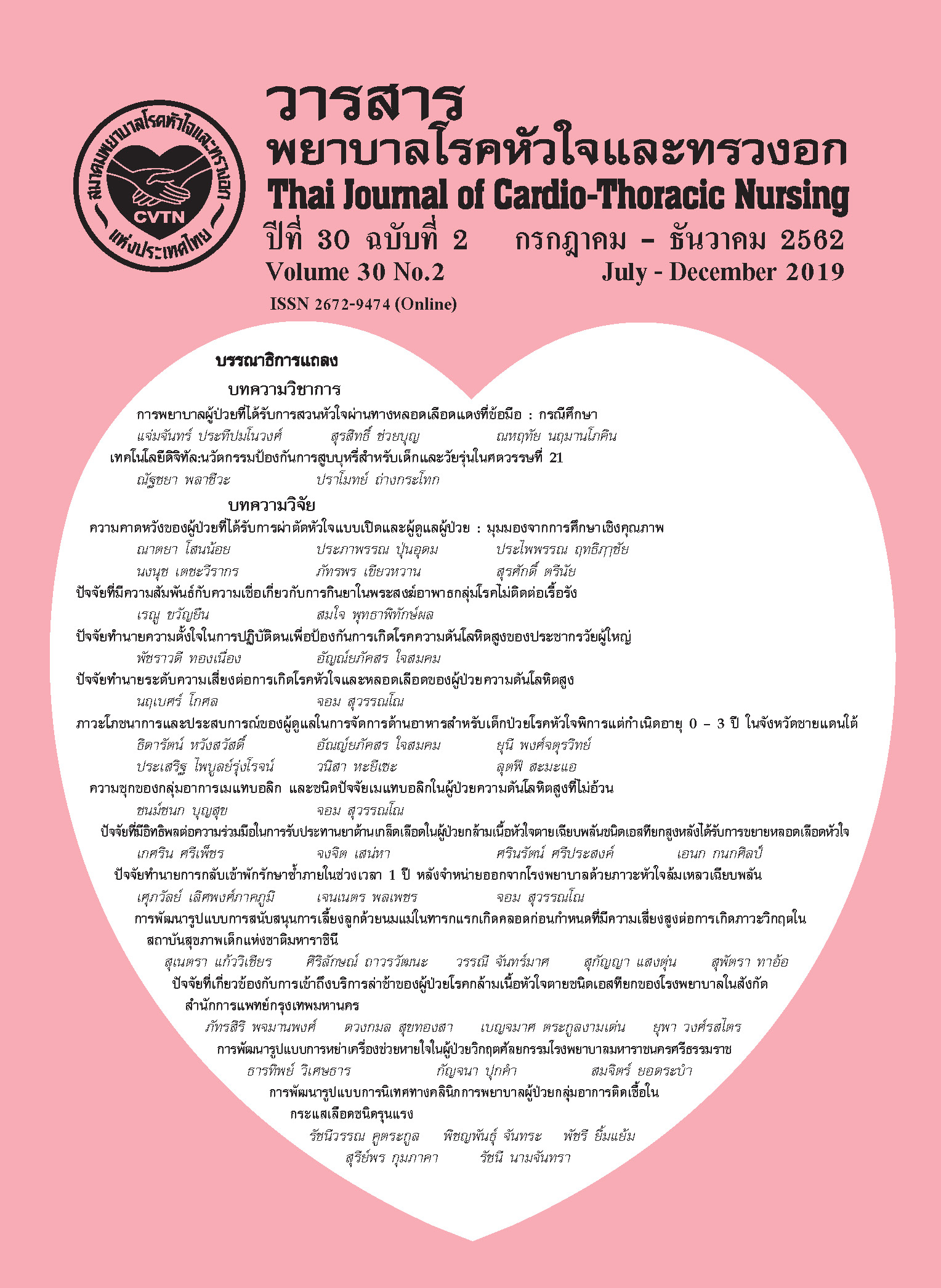The development of a clinical supervision model for severe sepsis patients
Keywords:
development, clinical supervision model, register nurse, severe sepsis patientsAbstract
This research and development study aimed to develop a clinical supervision model for severe sepsis patients by using Proctor’s model and to evaluate the outcomes of this developed model. There were 5 steps in study process; 1) survey of clinical supervision problems, 2) development of a clinical supervision model for severe sepsis patients, 3) pilot study of the clinical supervision model in clinical practices, 4) evaluation of the clinical supervision model 5) use of the clinical supervision model in the institution. The samples were 22 head nurses, 327 registered nurses, and medical records of severe sepsis patients before and after the development of the clinical supervision model, 73 patients’ records in each group. The research tools were 1) Focus group question, 2) clinical supervision model utilization questionnaires, 2) nursing knowledge tests, 3) records of care process and outcomes.
The results showed that the developed clinical supervision model to solve the problems and obstacle consisted of identifying roles and functions of supervisor, identifying issues of clinical supervision, collaboration between head nurse and staff nurses in planning and doing clinical supervision, including evaluation of clinical supervision. After development of a clinical supervision model for severe sepsis patients, the head nurses had improved knowledge and attitude on clinical supervision. The registered nurses had increased nursing care knowledge for severe sepsis patients after clinical supervision model implementation. There were significantly increased in rate of detection patient sign changes, rate of blood collection for hemoculture before antimicrobial administration, rate of antimicrobial administration within 1 hour, and rate of adequate tissue perfusion within 6 hours (p<.01).
Nurse administrators should continuously evaluate outcomes in caring of severe sepsis patients, and further develop clinical supervision models for other groups of patients.
References
Levy MM, Evans LE, Rhodes A. The Surviving Sepsis Campaign Bundle: 2018 update. Intensive Care Med. 2018;44(6):925-8.
Global Sepsis Alliance. Sepsis Facts [Internet]. 2013 [cited 2019 Nov 14]. Available from: https://www.world-sepsis-day.org/?MET=SHOWCONTAINER&vCONTAINERID=11
Rhodes A, Evans LE, Alhazzani W, Levy MM, Antonelli M, Ferrer R, et al. Surviving sepsis campaign: international guidelines for management of sepsis and septic shock 2016. Crit Care Med. 2017;45:486-552.
Ministry of Public Health. KPI 3 mortality rate in patients with severe sepsis. E-Inspection system 2561 [Internet]. 2018 [cited 2019 Nov 14]; 448-59. Available from: https://bie.moph.go.th/e-insreport_ex/index.php (in Thai).
Ministry of Public Health. Mortality rate in patients with severe sepsis [Internet]. 2018 [cited 2019 Nov 14] Available from: https://hdcservice.moph.go.th/hdc/reports/report_kpi.php?flag_kpi_level=1&flag_kpi_year=2018&source=pformated/format1.php&id=00366a85bd3c2b6932a228df29137252 (in Thai).
The Healthcare Accreditation Institute (Public Organization). Hospital and healthcare standards 4th Edition [Internet]. 2018. [cited 2019 Nov 14] Available from: https://hacc.kku.ac.th/haccupload_news/pdftitle/Tue85046L4FoA1d.pdf (in Thai).
Dellinger RP, Levy MM, Rhodes A, Annane D, Gerlach H, Opal SM, et al. (2013). Surviving sepsis campaign: international guidelines for management of severe sepsis and septic shock 2012. Intensive Care Med. 2013;39(2):165-228.
Rungthanakiat P, Promtuang S, Paengbuddee C. Development of the care model for patients with septicemia using fast track system at Surin Hospital. Thai Journal of Nursing and Midwifery Practice. 2019;6:36-51. (in Thai).
Komon P, Namjuntra R, Binhosen V. Quality of care management in persons with sepsis syndrome at emergency department in Singburi Hospital. Association Private Higher Education Institutions of Thailand Journals 2017; 6:32-43. (in Thai).
Saengsanga P, Kiamkan N. Outcomes of using the clinical practice guidelines for patients with severe sepsis or septic shock care according to sepsis bundle protocol at the ICU of Songkhla Hospital. Thailand Medical Journal. 2015;29:403-10. (in Thai).
The Healthcare Accreditation Institute (Public Organization). Spa & self & enquiry part I. Nontaburi: Nungserwandee Publishing; 2009. (in Thai).
Proctor B. Training for the supervision alliance attitude, skills and intention in fundamental themes in clinical supervision. London: Routledge; 2001.
Limtrakul D. Developing a nursing supervision model of anesthetist nurse division for standardize and quality of service. Hua Hin Sook Jai Klai Kangwon Journal 2019;4:1-14. (in Thai).
Songkarak S, Khaikeow S, Puttiungkoon B. The effects of clinical supervision program for first level nursing manager at a tertiary level hospital in Phetchaburi province. Journal of Charoenkrung Pracharak Hospital. 2018;14:35-47. (in Thai).
Kanokrat S, Suwabhabh D, Vitoonmetha M. Effects of clinical supervision on knowledge and ability to practice nursing for pain management in postoperative patients and satisfaction with nursing supervision. Journal of Nursing Division. 2009;36:1-14. (in Thai).
Tana P, Kanokrat S, Trakulsithichoke S. Effects of clinical supervision on the application of nursing process in caring of diabetic patients and nurses satisfaction. Journal of Nursing and Health Care. 2017;35:52-60. (in Thai).
Niyompraeg A, Jantara P, Yimyam P, Pakdeewong N. The development of a system for caring for patients with sepsis through evidence-based pracetice. Journal of Nurses’ Association of Thailand, North-Eastern Division 2013;31:14-24. (in Thai).
Nopparat rajathanee hospital. Inpatient statistics [Internet]. 2019 [cited 2019 Nov 14] Available from: https://www.nopparat.go.th/nrhweb/index.php (in Thai).
Shapiro NI, Howell MD, Talmor D, Lahey D, Ngo L, Buras J, et al. Implementation and outcomes of the multiple urgent sepsis therapies (MUST) protocol. Crit Care Med. 2006;34:1025–32.
Glass GV, McGaw B, Smith, ML. Meta-analysis in social research. London: SAGE Publications Inc; 1981.
Bloom BS, Hasting JT, Madaus GF. Handbook on formative and summative evaluation of student learning. New York: McGraw-Hill Book Co; 1971.
Knaus WA, Draper EA, Wagner DP, Zimmerman JE. APACHEII: A severity of disease classification system. Crit Care Med. 1985;13:818-29.
Supanpayob P, Sukadisai P, Amphon K. Developing nursing supervision model of nursing devision in Phrapokklao Hospital. Journal of Nursing and Education. 2013;6:1-15. (in Thai).
Chumpinij N, Moolsart S. The development of a clinical supervision model for head nurses at Bhumibol Adulyadej Hospital. Journal of the Police Nurse. 2015;7:77-89. (in Thai).
Yousefi H, Nahidian M, Sabouhi F. Review the effects of an educational program about sepsis care on knowledge, attitude, and practice of nurses in intensive care units. Iranian J Nursing Midwifery Res. 2012;17:91-5.
Dowling S. Implementing the supervisory process: Theory and practice. New Jersey: Prentice-Hall; 1992.
Downloads
Published
How to Cite
Issue
Section
License
บทความนี้ยังไม่เคยตีพิมพ์หรืออยู่ในระหว่างส่งไปตีพิมพ์ในวารสารอื่น ๆ มาก่อน และกองบรรณาธิการขอสงวนสิทธิ์ในการตรวจทาน และแก้ไขต้นฉบับตามเกณฑ์ของวารสาร ในกรณีที่เรื่องของท่านได้ได้รับการตีพิมพ์ในวารสารฉบับนี้ถือว่าเป็น ลิขสิทธิ์ของวารสารพยาบาลโรคหัวใจและทรวงอก






